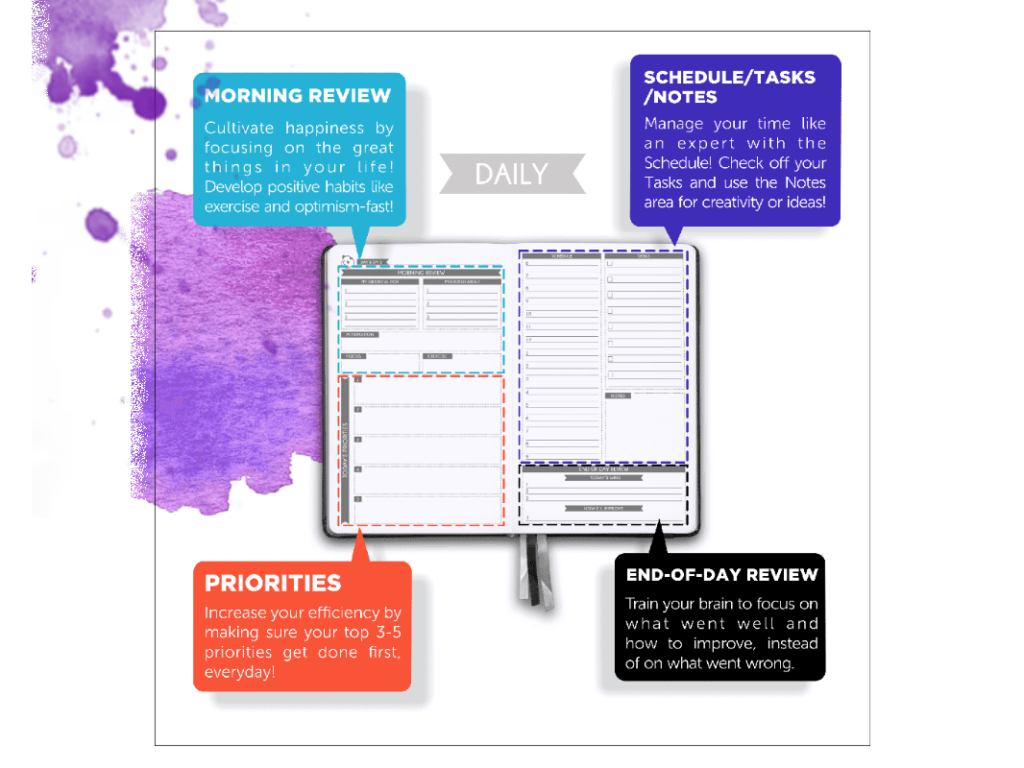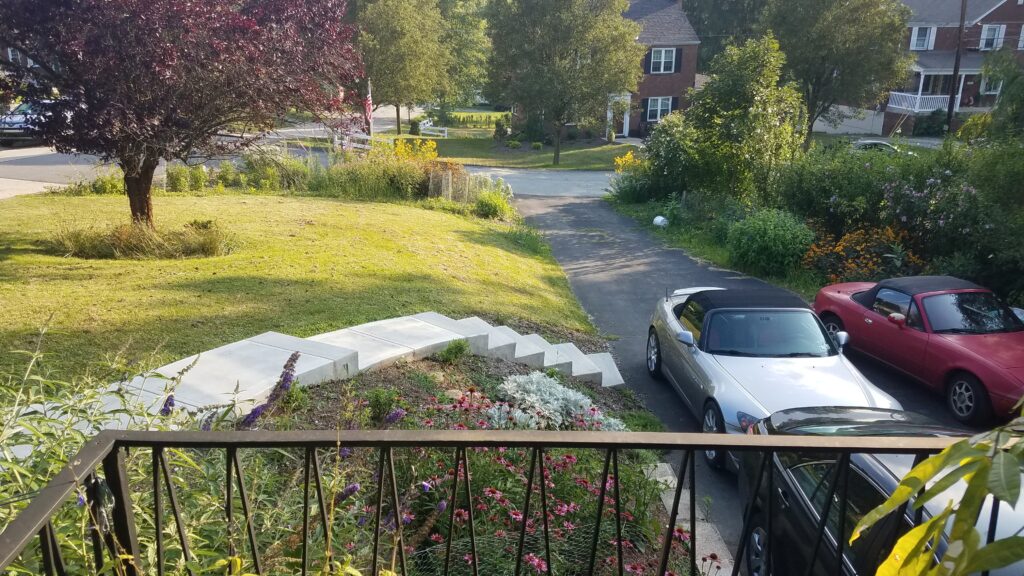Part 4 – Planning (Continued) and Evaluation
I keep my planner on my nightstand, which is not the best way to support marital bliss (since the light from my lamp and sound of my writing are unhelpful when my husband is trying to sleep). Ensuring it is there for easy access at the beginning and end of the day, however, has supported what I believe to be the most significant shift toward better mental health I believe I have ever experienced.
Beginning of the Day
The daily component of the planner begins with the very simple activity of listing three things for which you are grateful (they could be as simple as a good cup of coffee or snuggles with your cat) and three things about which you are excited. The act of practicing gratitude on a regular basis is connected with better psychological and even physical health outcomes. [1],[2] I told my mom about the shift I have experienced personally, and while she uses a different word for the activity – prayer – she said she feels similar benefits.
In addition to providing a structured approach for practicing mindfulness and gratitude, there is also a space on the page to say some kind words about yourself and identify your own priorities before even looking at your schedule or what others are expecting of you over the course of the day. As I’ve mentioned before, I do have some difficulty breaking out of the to-do list mentality when using a planner, and that is especially difficult at the most granular daily level.

Ultimately, though, I do use this time to identify the things I want to prioritize and reflect on how well I’ve defended those choices.
Image credit: [3]
Still, I have seen some success when, instead of creating a to-do list for the day, I first identify broader qualities I want to embody or improve (e.g. being a good leader). From there, I allow myself to make a mini to-do list under each heading, providing examples of things that can support that quality or concept (e.g. writing a card to a teammate, preparing for a strategy meeting, representing my organization well at an event, etc.). If I achieve just some of the examples – or even things like them – then I have worked toward that priority in some amount with a level of flexibility that allows me to pivot as needed during the day. Since adopting this approach, I’ve noticed that even if I don’t get to everything I intended, I am far more likely to think about my day positively when it’s in the context of taking a few steps toward a goal, than if I’m looking at an incomplete and unrealistic to-do list.
My planner has a daily schedule built in, which provides the opportunity for us visual people to see the day at a glance. I will start by listing the meetings or obligations I have at specific times and then schedule time for my own priorities in the gaps. Of course, schedules don’t always go according to plan, and, of course, some of us are wont to drop whatever we’re doing to put out fires, thus deviating from the plan entirely. But building the habit of creating and defending time for yourself is an essential first step in the practice of being truly productive, and I find that if I actually schedule the time to do something (and communicate that I will be unavailable for the duration), I am far more likely to do it.
Evaluation
End of the Day
Improvement of any kind requires an assessment of your performance in relation to a goal so you know how to improve. We generally take this approach in the business world, but we so rarely do it as individuals – or, in my case, we do it poorly, and use it as a way to beat up on ourselves. The “End of Day Review” in the Panda Planner asks you to list three wins and one way to improve. When I failed at my first Panda Planner attempt in 2019, my thoughts on how to improve usually focused on getting to more of my unfinished to-do list. I pushed harder and harder over time until I was frustrated with myself and the process. But this time around, most of my opportunities for improvement have to do with self care (e.g. getting enough water, remembering to eat, or taking my vitamins), but I will also give myself an occasional “no notes” at the end of a really great day when I feel like I’m very much living my values.
End of the Week
The Week-End Review is tucked into the top of each new week’s page, providing space for five big wins and two opportunities for improvement. Sometimes I will complete all five of my goals for the week; sometimes I won’t complete any. So much depends on how realistic my goals were in the first place and how much the week did or didn’t go according to plan. Ultimately, I worry less about whether I hit my expected goals and focus more on the wins I had. It’s also a nice exercise to flip through the pages of the past week and revisit my accomplishments. Sometimes I’ll completely forget what happened the prior Monday or Wednesday, and the recap gives me a nice psychological boost (which is part of the point of the exercise).

End of the Month
At the end of the month, you can identify three specific big wins you had related to larger goals, which may or may not align with the goals you set at the beginning of the month. Mine rarely match up, but it is still incredibly satisfying to look back and reinforce that I accomplished something significant, even if it wasn’t what I had originally planned. That isn’t to say we should abandon our goals, but we should continue to ask ourselves if certain activities support or distract from the longer-term visions we’ve imagined. And sometimes as priorities shift we take on a different perspective or gain certain insights – there is space for those too, and I find those can help guide my goal-setting for the following month.
The Bigger Picture
We often don’t take a step back and look at ourselves in the context of where we are and where we’re headed unless we’re forced to – at least that’s the case for me. The last time I did it in any significant way (more than my typical New Year’s Resolution approach), I was changing jobs after getting a gentle shove out of the nest by the best boss I’ve ever had. I was so intentional about my next career steps that I converted a wall in our guest room into an idea/research board, and I spent hours in there writing, meditating, and ultimately interviewing for a job that aligned with my values and goals. [4] (Spoiler alert: three and a half years later, it still is my dream job.)
Amusingly, a few weeks ago, just as I was writing about Charles Duhigg describing how our priorities can shift from day to day,[5] I had a significant priority shift of my own. What was originally supposed to be a quiet week for me, decompressing from the fiscal year end with some gardening, cooking, and reading, turned into a frenzy of applying to a highly selective leadership program focused on developing community-oriented solutions to climate change. A friend told me about it on Tuesday night, and by Wednesday morning, I was eyeballs deep in assembling writing samples, references, and thinking deeply about the path of my educational and professional journey over the last 20(!) years and where it’s heading.
That shift in my time and attention was unexpected, but I don’t think it was a waste of effort, even if my application isn’t accepted. While it was exhausting to pull the materials together three days before the deadline, it was also an amazing exercise for me. The process helped me view in 20/20 hindsight the seemingly disparate pieces of my education and career (related to physics, business, teaching, travel, etc.) in the context of where I am now and how I can affect positive change in the world (related to responsible resource use that impacts public health, environmental health, and social equity). If that wasn’t a great way to help reinforce what’s important to me, I don’t know what is.

But I bring it up to demonstrate that we need to create opportunities for periodic evaluation of ourselves, or we likely won’t do it – and the longer we go in between those evaluations, the bigger the lift it will likely be when we finally do it. Many of us will do some thinking about what we want from life when we change jobs, but not so much in the interim. Consequently it had been almost four years since I seriously considered the type of impact I want to have on the world and whether I’m still on track to do that. This application process helped me see how I could best leverage my knowledge and skills from where I am now, and I have felt more focused even in my monthly, weekly, and daily Panda Planner use since checking in on a higher-level vision. Given how helpful that experience was in reaffirming my perspective, I think I will be using built-in evaluation and goal-setting opportunities, such as New Year’s, more regularly and effectively in the future.
~
This whole series was born from a conversation I had with a friend about productivity and how to organize to-do lists effectively. I’m sure there will be more to come on this subject in the future as I continue to figure out what works for me. But in the meantime, I’d love to hear about your approaches, successes, and lessons learned related to anything you’ve tried.
Thanks for reading!
[1] https://www.health.harvard.edu/healthbeat/giving-thanks-can-make-you-happier
[3] https://pandaplanner.com/products/panda-planner-classic-original
[4] https://radicalmoderate.online/new-years-resolutions-and-the-courage-to-be-disliked/
[5] https://brenebrown.com/podcast/brene-with-charles-duhigg-on-habits-and-productivity/
0 Comments